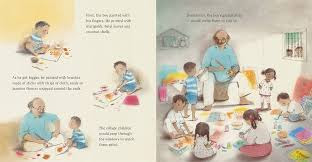"One's butt is splashed
with colored streaks.
Some primates store
food in their cheeks.
One primate wears
a cute mustache.
Another likes
to soak and splash."
The endpapers are an enticing invitation to get right into this book that offers a field study of animals from around the globe. A world map plots the journey that will be taken to explore where the various primates live. The packing list begins with an admonition not to forget to feed the cat before venturing forth, and another that suggests coming home is the final leg of the journey. The in-between list is long and relevant for the trip ahead (including jam sandwiches for the trekkers and lots of bananas for the primates to be researched).
The text begins with the ways in which primates are the same: they climb, breathe air, have big brains, hands and hair. There are also observable differences: where they live, how they look, their hunting habits, their anatomy, how they spend their time and where they sleep.
"Peculiar looks,
odd things they do.
Some primates can
be strange, it's true."
It's important for kids to realize they are primates, too.
Debra Kempf Shumaker has filled the pages with details that grab attention and inform in a most enjoyable way. Claire Powell uses a bright color palette, constant movement, expressive faces and careful labels to move readers from one spread to the next.
Back matter adds further information for each featured primate visited, as well as a list of websites, books, and videos for further learning.
If you enjoy this book, be sure to see if you can find a copy of Freaky, Funky Fish. (Running Press Kids, 2021)






















































